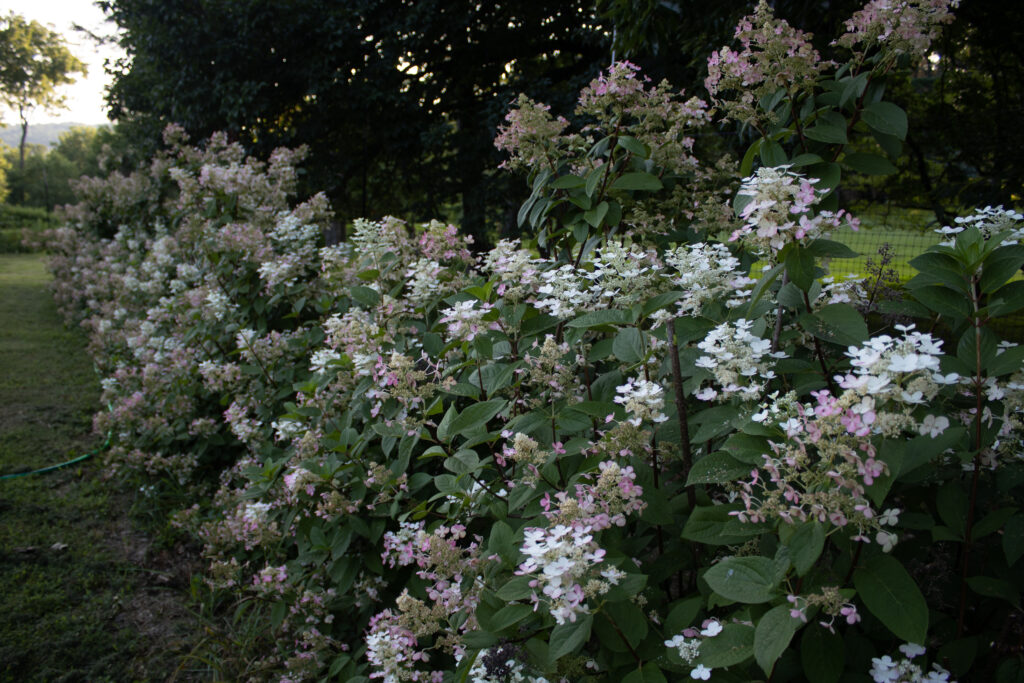It is peak local hydrangea season here in Philadelphia at the moment. Everyone is familiar with the classic big blue bloom. But did you know there are over 70 varieties of hydrangeas? Each has it’s on unique beauty and each lends itself in different ways to designs. So let’s learn a little more about hydrangeas!
First up is that big blue guy, Hydrangea macrophylla, or better known as mophead hydrangeas. Typically you will not see our local growers offering these. That’s because this type of hydrangea blooms on “old wood”, meaning the stem a bloom is on has to be at least two years old. It’s hard to make a profit on a flower that takes two years to bloom and is ubiquitous in the import market. So we generally just skip that one.
What you’ll see more of from PFG farms are Hydrangea paniculata, Hydrangea arborescens and Hydrangea quercifolia. Big Latin names you don’t really need to remember unless you want to be garden geeks with us (yes please!) As a florist, here’s what you really need to know about the hydrangea varieties on offer at PFG: there are the big fat footballs (H. arborescens) and then there are the delicate textural butterflies (H. paniculata).

As you might imagine, the big fat footballs are really great for big installation work, urns, and tall centerpieces. They take up real estate fast and always look classy. Pictured above on the right is Hydrangea ‘Fire Light” and pictured below are Hydrangea ’Limelight’, both excellent for large scale designs. With some editing, you can also use these big footballs in smaller vase arrangements by chopping out half the flower.
Instead of performing hydrangea lobotomies for centerpieces though, consider using the more delicate Hydrangea paniculata. These “butterflies on stems” elevate any arrangement and make quick work of designing since they act as both focal and filler. While they are a bit pricey per stem, you’ll speed up your design time exponentially, which brings down the cost of your labor, ultimately saving you money. Cha-ching!
Special Note: If you’re ordering hydrangeas from PFG for hand-tied bouquets, please be sure to leave a note with your order to that effect. We’ll custom harvest more slender stems with smaller blooms so they are more suitable for carry bouquets.

By the way, the name hydrangea stems from the Greek roots ‘hydor’ and ‘angos’, which translates roughly into “water vessel”. It’s a fitting name because hydrangeas are water guzzlers, sucking up quite a bit more water than most flowers. When receiving your orders with hydrangeas, always make sure to process them first and get them into buckets with at least 4″ of water in the bottom, ideally even more. It’s not unusual for hydrangeas to suck a bucket dry in a day, particularly if they are exposed to sunlight or a warm breeze, like your shop door opening and closing on a hot day. The reason for this is that the wide and abundant petals of a hydrangea bloom are constantly respiring (sort of like our sweating), which means the stems draws up a lot of water to replace what is being lost through the petals.
It is often assumed that because hydrangeas make excellent cut flowers that they don’t need much water in the vase. However, young hydrangeas with soft, supple petals are very prone to wilting. Remind your customers of that. Only once mature (“antiqued”) are hydrangeas robust enough to dry since their petals have stiffened with age.
Three tricks for helping hydrangeas stay hydrated:
- From the bottom of the stem, slice up the middle about three inches with a sharp knife. This exposes ore surface area for the stem to be able to absorb more water. Never (ever!) smash the stem with a hammer. This damages the cell structure that is so vital for drawing up water. Have a look at a botany book and you’ll see pretty quickly how smashing woody stems like hdyrangea is a no-no.
- Fill up a sink or procona with a lot of cool fresh water. Submerge your limp hydrangeas, flower head and all, entirely under the water. Let soak for at least 30 minutes or even overnight. They should plump up and look great again as long as they hadn’t gotten crispy in their dehydrated state.
- Avoid strong sunlight or hot wind. No amount of conditioning or water in the vase/bucket is going to keep a tender hydrangea perky if it’s under such stress. For this reason, always add hydrangeas at the last minute to outdoor installations and always make sure they’re water tubed. The exception being come October when the weather is cool and the hydrangeas very antiqued – then you can shove them in with wild abandon, no water tube needed.

Pictured above is Hydrangea ‘Quickfire’ on the left and Hydrangea ‘Incredibal’ on the right in their antiqued pink stage. At this stage, these hydrangea are much sturdier and not nearly as thirsty as in their white or blush stages. Excellent candidates for all your autumn wedding work as they will not wilt and can be easily dried to look almost identical!
All the photos in this article were provided by Love ‘n Fresh Flowers, PFG’s hydrangea specialist.
Shop Our Hydrangea Selections Now
Want to learn more about local flowers? Check out our article on zininas and our article on lisianthus.

